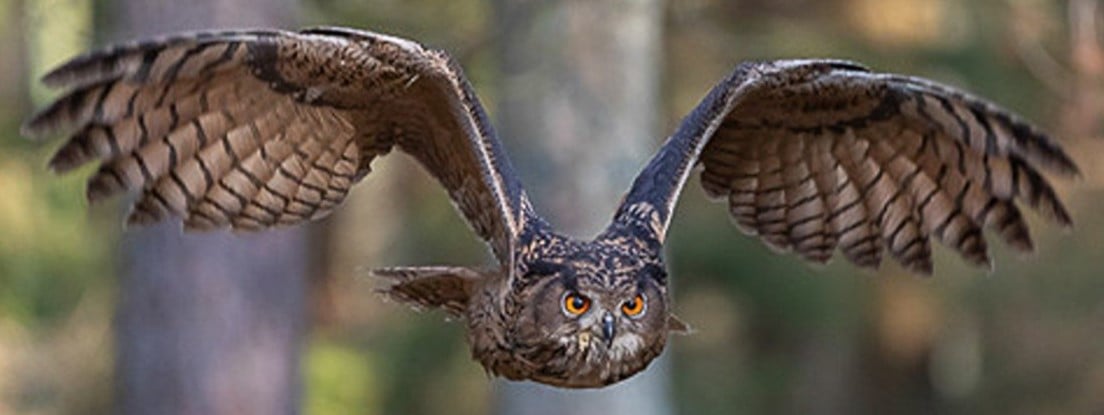From Owl and Raptor Center Haringsee
Do you know the largest native (German) owl species? It's the beautiful eagle owl. The eagle owl has a pair of striking, long, feathered ears, large orange-red eyes, and a characteristically thick head.
Eagle owls prefer richly structured, diverse landscapes where they can find good hunting grounds, suitable breeding sites, and daytime hides. They particularly like to fly to bodies of water to hunt, and they prefer covered areas on rock faces to breed, but can also feed their young in sand and clay pits, on the forest floor, or in tree nests.
The eagle owl's menu is very varied: from shrews to foxes, from sparrows to female hawks and grey herons, it will also eat fish, large beetles, grasshoppers, earthworms, and snails. Especially in winter, it will also feast on carrion and meat scraps. It also builds up a reserve layer of blubber in the fall, which allows it to survive very long periods of hunger.
Original German
Kennt ihr die größte heimische Eulenart? Es ist der wunderschöne Uhu. Der Uhu besitzt ein Paar auffällige lange Federohren, große orangerote Augen und einen charakteristisch dicken Kopf. Uhus bevorzugen reich gegliederte, abwechslungsreiche Landschaften, in denen sie gute Jagdgebiete, geeignete Brutplätze sowie Tageseinstände finden. Zur Jagd fliegen sie besonders gerne an Gewässer, zur Brut bevorzugen sie überdachte Stellen in Felswänden, können jedoch auch in Sand- und Lehmgruben, am Waldboden oder in Baumhorsten ihre Jungen versorgen.
Die Speisekarte des Uhus ist sehr vielseitig: Von der Spitzmaus bis zum Fuchs, vom Sperling bis zum Habichtsweibchen oder Graureiher, aber auch Fischen, großen Käfern, Heuschrecken, Regenwürmern und Schnecken verschmäht er nichts. Besonders im Winter geht er auch an Aas und Fleischabfälle.
Außerdem legt er im Herbst eine Reserve-Speckschicht an, durch die er sehr lange Hungerperioden überstehen kann.


Unfortunately for me, there’s none in the nearest zoos, which isn’t surprising since they’re mostly focused on “exotic” animals. I’ll probably have to wait a few years before I’m able to travel in another region to visit a zoo that has an eagle owl.
But while searching, I saw that the zoo near my summer workplace has snowy owls, maybe I’ll go take a look one of these days!
What?! That's crazy! I would think everyone would want an Eagle Owl. Even if they're a regular resident, it's not like people get to regularly see them up close.
I saw my first Snowy this year. I wanted to see if it lived up to the hype from all the memes and such.
The one I saw exceeded expectations! He was totally charming and made many great faces. I think anyone who likes them in photos would love them in person. Very beautiful owls!
I don’t know, you’d think it would be easy for them to get eagle owls since they’re local, but they’re wild animals, so it’s probably not that simple? Obviously they can’t take them from the wild. And in the end, only few zoos are easily accessible (without a car) from my home, so it’s not that surprising that they don’t have one particular species. Space is precious, after all, and there are so many amazing animals, they have to make choices I guess.
I looked a bit more, and there seem to be eagle owls in two not-too-far-but-not-too-close zoos that I didn’t know or think about, which could be reachable in a big day trip even without a car. One of them is in a forest and has a lot of forest mammals as well as raptors, it looks really nice and different from the zoos closer to me. I’m a student-worker, though, so when I get a day off it’s generally spent either studying or trying to fix something in my apartment or desperately trying to rest. Even a day trip can be difficult. :-( Maybe I’ll be able find some time, we’ll see.
There are animals that are injured and can't be released and survive, and there are also animals born to be raised by people as educational animals. Zoos will also trade animals with each other, so if a zoo would have a mated pair of Eagle Owls and it had a chick, they could exchange it with another place for another animal they have an extra of. Those are the ways I know of that they get animals for display here anyway.
The one in the forest sounds nice, like that raptor center in Germany I get posts from. Even if it's captive, you're seeing it in a situation somewhat closer to its natural environment.
Don't kill yourself to go see it, I will keep you stocked with owl entertainment until the opportunity arises for you!
In the worst-case scenario, it can be a reward-trip for getting my diploma in a few years! I’m counting on you in the meanwhile, ha ha.